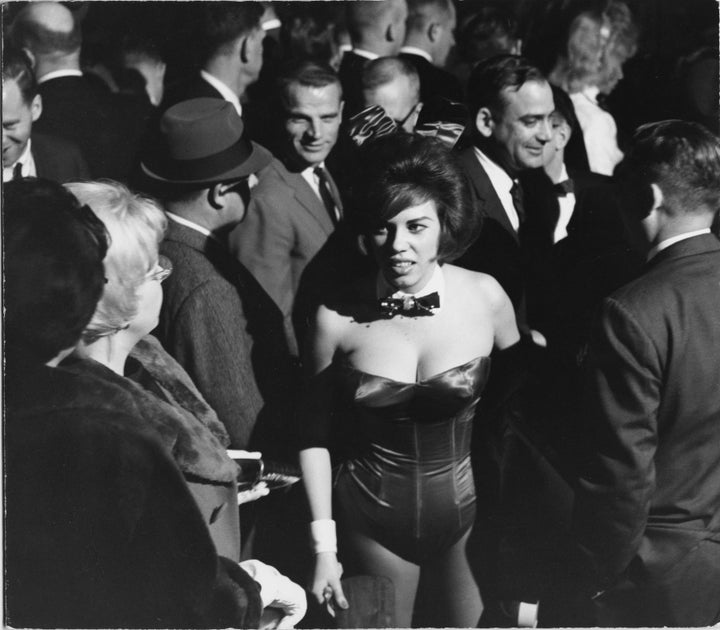[ad_1]
It is almost an entirely different experience watching A&E’s “Secrets of Playboy” as opposed to “We Need to Talk about Cosby,” “Surviving R. Kelly” and other recent docuseries that allege decades of sexual abuse by public figures.
That’s not to say it’s any less harrowing to listen to women in the docuseries describe violations of their bodies that were perpetuated, or orchestrated, by a man they revered: Hugh Hefner. It’s that the allegations aren’t particularly shocking when the image of the late Playboy founder who perpetually walked around in a plush bathrobe, with interchangeable women on his arms wearing pink bunny ears and corsets, is emblazoned in our minds.
Hefner would most certainly be “canceled” in 2022 on account of his blatant misogyny, and “Secrets of Playboy” asks us to grapple with the notion that someone like him would appeal to everyday women desiring sexual agency in 1953 when the soft porn men’s magazine launched.
As Los Angeles Times TV critic Lorraine Ali put it, “Exactly no one will be surprised to discover that the late Hugh Hefner used and traded young women like commodities and that his mythology of Playboy as a progressive outgrowth of the sexual revolution and a bold expression of feminism was largely a charade.”
At the risk of victim-blaming, Ali makes a valid point. But it’s worth taking a step back to look at the landscape for women at the time to gain some perspective — and examine today’s culture to see how little things have changed. In the postwar era and throughout the ’70s, Hefner saw an opportunity to capitalize on feminist sentiment growing among white housewives and young women whose career prospects were often limited to secretarial positions.
Their yearning to be seen as sexual beings was a byproduct of every other aspect of their lives being controlled. Hefner offered them an opportunity to be a part of his Playboy family with photoshoots and glitz — which later spiraled into nude videos filmed without their consent and being passed around for sex with Hefner or A-listers like Don Cornelius — through the guise of becoming liberated women.

Stephen Deutch/Chicago History Museum/Getty Images
The survivors interviewed in “Secrets of Playboy” — Playboy bunnies (waitresses at the Playboy clubs), playmates (the magazine’s nude centerfolds) and/or Hefner’s ex-girlfriends — initially saw Playboy as beneficial to them while they acknowledged the brand’s chauvinism.
Carrie Pitzulo, author of “Bachelors and Bunnies: The Sexual Politics of Playboy,” which explores the socio-historical context of the Playboy legacy, heard the same thing from women she interviewed. “Many of them said, ‘It made me feel like a liberated woman, even though I knew it was really sexist,’” she recalled to HuffPost. “‘It was a decent paying job, way better than becoming a secretary or something.’”
Still, it’s debatable whether these women achieved any level of sexual empowerment at all when straight men seemingly benefited from their sexuality the entire time. And that begs the question: Could the women of Playboy have ever gained authority over their sexuality without simultaneously falling prey to the straight male fantasy?
Pitzulo suggests that these women could feel sexual liberation while also becoming a byproduct of straight male sexual fantasy. “I think both things can be true,” Pitzulo said. “What does [her sexual freedom] mean for him? What is his motivation? What does it mean for the [Playboy] reader and his motivation? What does it mean for the model and her motivation? These can be different things.”
But we’ve seen the motivations of sexually liberated women, through no fault of their own, be commandeered by men’s interests countless times. Just within the branches of the Playboy family tree, Canadian-born girl-next-door Pamela Anderson appeared on the cover of the magazine 14 times between 1989 and 2016 — and was also known as the hot “Baywatch” bimbo a significant portion of that time.

Photo by Erin Simkin/HULU
As empowered as Anderson might have and should have felt, she was also exploited and even ridiculed by men who simultaneously lusted after and condemned her sexuality. “Pam & Tommy,” the new Hulu series that dramatizes the fallout from her unlawfully leaked sex tape with her former husband Tommy Lee, details how her acting career was never taken seriously because people only really saw her as a sexual object. The inherent problem, the male gaze, wasn’t hers to fix, and yet she was being punished for it.
Part of that could be due to the fact that, as Pitzulo states, the pipeline from Playboy centerfold to Hollywood success story was and is still extremely uncommon because of that stereotype of “the naked blonde bimbo.”
“I think it became a little bit more possible, and that probably just has to do with changes in our overall celebrity culture and things like that, but it was still very rare,” she said. “Most women who were centerfolds just went on leading their normal lives after that.”
This brings us back to the “Secrets of Playboy” and the question of whether women throughout the brand’s history ever truly ascended socially when their options remained so limited. And by extension, will their allegations, including those of former bunny and Hefner’s ex Holly Madison, who published a 2016 book about her horrid experiences, ever be taken seriously?

Ken Hively/Los Angeles Times via Getty Images
From this, it’s easy to consider female sexual empowerment largely a myth when the male gaze still has such a chokehold on our culture, as evidenced on magazine covers, movie posters, album covers, films, music videos and songs — even some with feminist messaging. Are today’s women any more sexually free than they were when Playboy started?
“We’re talking about liberation in 2022 versus liberation in 1960, and things have changed, thank goodness, but we still live in a very sexist, racist, heteronormative culture,” Pitzulo said. She added that even in today’s era of Me Too and the sexual revolution, our culture is still far from truly accepting female sexual agency.
“Men have always had almost entirely free rein to do what they want sexually — straight men, at least,” she continued. “I’m grateful that the Me Too movement happened, but we already talk about it in the past tense. Has the problem gone away? I don’t think we’ve reconciled anything.”
Need help? Visit RAINN’s National Sexual Assault Online Hotline or the National Sexual Violence Resource Center’s website.
[ad_2]
Source link
